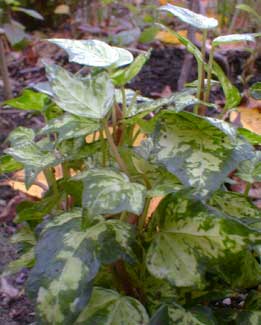
'Golden Ingot'
English Ivy
"His affections, like ivy, were the growth of time."
-Robert Louis Stevenson
(1850-1894)
(1850-1894)
The ivy cultivar 'Golden Ingot' (aka 'Golden Inge') was developed in Denmark. It received the Award of Garden Merit from the Royal Horticulatural Society in 2002, & was selected by the American Ivy Society as the non-invasive Ivy of the Year for 2003. Such recognition caused it almost immediately to be added to growers' stocks nationwide, rendering it very widely available.
This variegated ivy is generally emerald-edged & gold-centered with splashes of grey-green interupting the gold. It can be quite varied plant however, & the color scheme is frequently reversed as gold-edged with emerald center. It is sometimes greatly grey-flecked almost as though it were peppered, to grey-blotched, elsetimes with nearly no grey at all. The distribution of the gold can be lopsided & only partially touching the edge.
Of the plants I've seen from different growers, it appears to me that when 'Golden Ingot' has gold edges the emerald center is rather evenly ivy-shaped, but when the edges are emerald, the golden center is flecked, clouded, & unevenly shaped, as iis ours, shown in the photo above.
Some of them are so distinct from one another that it can seem odd they're all called 'Golden Ingot' & it might seem wise to acknowledge "forms" of this cultivar (flecked & unflecked; gold-edged or gold-centered). The problem with attempting such specific definitions is that even a single spreading vine can have different kinds of leaves develop on different branches, or leaves can change their specific appearance as they age or dependent on amount of sun exposure, decreasing the degree of variegation when in deep shade. For propogation purposes it is important to select stems with maximum gold & least amount of grey to preserve formost the emerald-&-gold ideal.
For shape 'Golden Ingot' has a broad triangular "regular" leaf which in the Pierot Classification System is "Ivy Ivy." Other classes include "Birdsfoot Ivy" (very deeply cut), "Fan Ivy," "Curly-leaf," "Variegated," & "Heart-shaped." Missing from this system (though perhaps in the future it will be amended) are "Duckfoot" (apparently included among Fan ivies) & "Ovate" (apparently included among Heart-shaped though ovals aren't hearts). Many ivies fit more than one classification so 'Golden Ingot' is of course also in the class "Variegated."
The Pierot system does not quantify size except for the category "Miniature" (under one-inch). It might be improved or fine-tuned with the addition of "Mid-size" & "Large" of which 'Golden Ingot' would be mid-sized. Young starts can appear to be miniature but when it gets going the leaves will be two inches or a bit larger.
It may require some pinching to be extremely compact & strongly self-branching, but will be fairly self-branching even without pinching & over time will become a dense groundcover. It's also a good climber or will dangle nicely out of baskets or off ledges. Some variegated forms are very slow-growing, but after a year of establishing its root system, 'Golden Ingot' will begin to fill in an area more quickly than most variegateds.
The golden coloration is brightest when grown in sun. The vines will do well in deep shade but wukk have less striking gold. In bright shade it will still have good color. It can tolerate considerable droughtiness, but will spread more quickly in moist well-drained soil.
This variety has been field tested in climates as diverse as chilly Ohio & warm southern California & found to be extremely hardy in a very wide range of conditions, though in warmer climates the gold will be closer to cream colored.
For other variegated small-leaf ivies, see wavy-edged 'Golden Curl,' yellow-centered 'Goldheart' white-edged 'Ingrid,' & frosted 'Jubilee.'